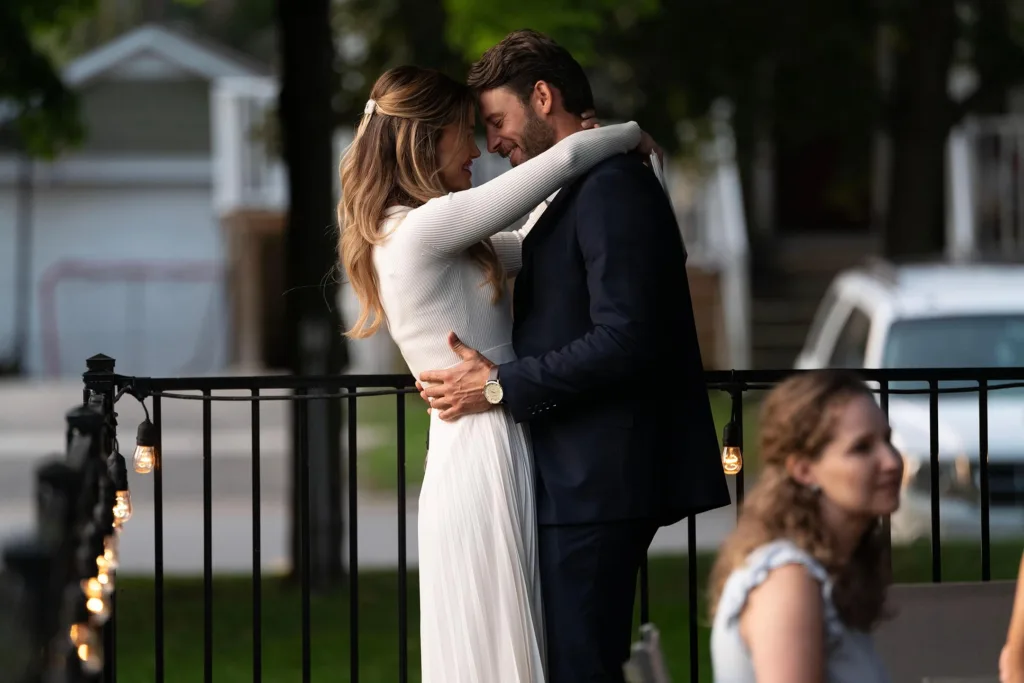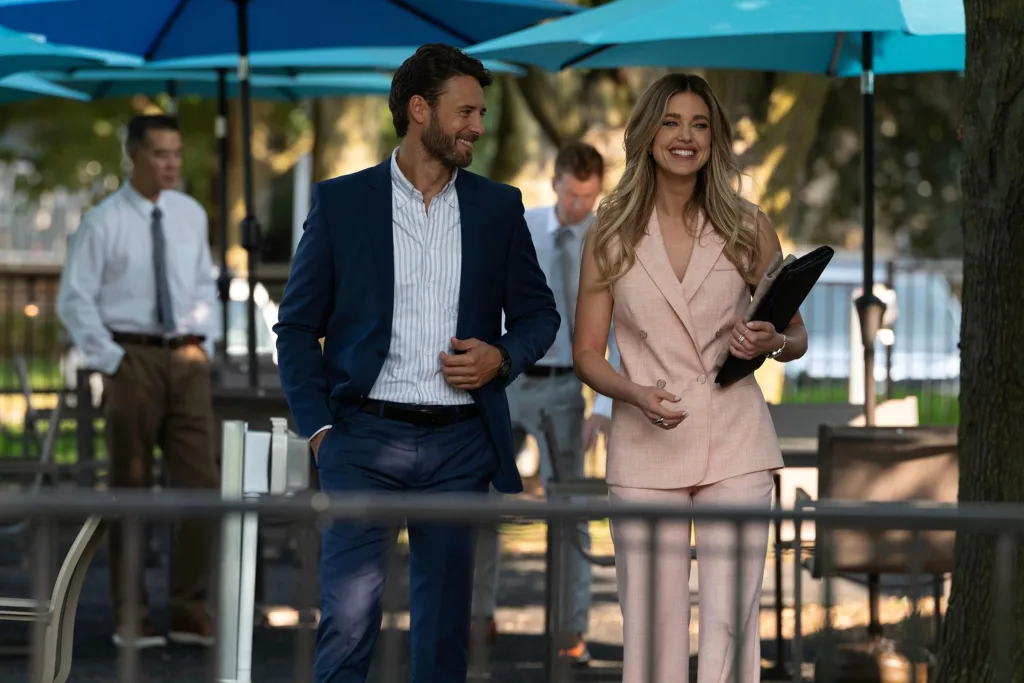In this first installment of a new series, Hearts Around the Table: Jenna’s First Love introduces us to a modern family formed through adoptive connections that bring together an assortment of lives under one roof. The narrative centers on Jenna, an accomplished event planner whose early hardships have shaped her into a determined and compassionate professional.
Her life takes an unexpected turn when she reconnects with an ex from her past, sparking a blend of professional commitments and personal memories. The storyline unfolds against the backdrop of Washington D.C.’s bustling urban energy, paired with scenes set in warm, inviting homes where intimate gatherings highlight the ties between family members.
The film uses a storytelling style that challenges routine narrative methods, experimenting with sequence and timing to create moments that are both playful and reflective. This fresh approach to structure adds an element of surprise that draws viewers into Jenna’s experiences, echoing the creative spirit of French New Wave films—a genre that has long influenced my appreciation for cinema.
The work stands as a cultural artifact, mirroring shifts in societal values and the reimagining of familiar roles, all while inviting audiences to explore personal renewal through renewed connections from one’s past.
Plot and Story Structure
The narrative centers on Jenna, a skilled event planner whose career success is balanced against a past filled with personal challenges. The film sets the stage with a surprise encounter when Jenna unexpectedly meets her ex, Andrew, at a charity event planning meeting.
Their meeting triggers a series of events filled with emotional tension and the weight of unresolved memories. The initial encounter bristles with a mix of professional duty and lingering personal emotions, establishing a spark that reshapes Jenna’s day and hints at deeper conflicts.
This meeting acts as a turning point, setting off a chain reaction that reintroduces old feelings while stirring up complications in Jenna’s current life. Her work, which demands both precision and creativity, finds itself in a collision with a personal history that refuses to stay buried.
The narrative takes a playful approach to familiar romance tropes by mixing scenes of witty exchanges and heartfelt moments. The tension between Jenna and Andrew is built through carefully timed sequences that recall the inventive spirit of French New Wave cinema—a style I admire in directors like Godard and Truffaut. These sequences are marked by unexpected cuts and a rhythmic pacing that keeps the viewer engaged.
Adding layers to the main storyline, the film features regular gatherings with Jenna’s chosen family—a group of siblings who meet weekly over dinner. These scenes offer a refreshing counterbalance to the central romance by highlighting everyday moments of support and care. The inclusion of a new, younger member in the family circle introduces fresh challenges and responsibilities, enriching the narrative with warmth and responsibility.
The pacing fluctuates gracefully between light-hearted banter and moments of reflective tension, ensuring that each shift in the storyline feels earned and natural. A key turning point emerges when Jenna is forced to weigh the comfort of her established routine against the stirrings of a past she once hoped to leave behind.
Character Analysis and Performances
Jenna’s background as a young woman raised within an adoptive family shines through in every scene. She has transformed challenging early experiences into a determination that powers her career as a skilled event planner. Her character displays confidence during high-profile charity events, where she balances precision with a sense of genuine warmth.
Moments in the film capture her ability to handle pressure with ease, while subtle expressions reveal a lingering tenderness tied to memories of the past. This mix of professionalism and sensitivity makes Jenna a compelling figure, as she navigates a personal reunion that stirs up both admiration and discomfort.
Andrew’s role brings a distinct layer of emotional complexity. His portrayal conveys a man burdened by regret over decisions made during his youth. There is a clear sense of internal conflict as he contends with a past that continues to haunt him.
The actor brings a quiet intensity to scenes where Andrew’s emotions surface—expressions of remorse and brief flashes of vulnerability mix with moments of a more irritable temperament. These contrasting aspects invite the viewer to consider his evolution, as he slowly learns to accept responsibility for his earlier actions while searching for a path to redemption.
The cast portraying Jenna’s adoptive siblings and the nurturing mother injects the narrative with energy and care. A particular sibling stands out, offering a protective perspective that challenges Jenna’s decisions with a blend of caution and concern.
The mother figure, ever gentle and wise, provides essential support through small gestures and words of encouragement. A new, younger member of the family adds another facet to the on-screen dynamic, representing both fresh hope and the continuing cycle of familial support.
The interplay between Jenna and Andrew is underscored by a mix of lighthearted exchanges and moments filled with unspoken emotion. Group scenes highlight the closeness among the family members, with each conversation reinforcing the strong connections that keep the group united.
Themes and Emotional Core
The film centers on the revival of a past relationship, bringing Jenna and Andrew together in a way that casts familiar emotions in a fresh light. Their connection is presented as a chance to reawaken old feelings, with both characters working to clear away regrets and allow themselves to trust again. Their evolving dynamic calls to mind the raw sincerity found in certain French New Wave works—a personal nod to films by directors I admire like Godard and Truffaut.
The portrayal of an adoptive family offers a powerful look at connections built through shared experiences rather than blood ties. The regular dinner gatherings serve as a visual motif, emphasizing how communal support and care can form a steady foundation amid life’s uncertainties. These scenes are crafted with a keen eye on human interaction, providing a gentle reminder that genuine connection often comes from choosing one another every day.
Jenna’s transformation from a difficult early life to a state of assured professional success speaks to the strength of self-acceptance and perseverance. Her determination is matched by Andrew’s internal struggle with past mistakes—a performance marked by moments of honest vulnerability alongside brief flashes of irritation. Their portrayals bring forward a nuanced exploration of personal growth that mirrors current societal reflections on second chances and learning from one’s past.
The film also examines the delicate balance between ambition and the heart’s longings. Jenna is shown managing the pressures of a demanding career while still contending with lingering personal memories. The careful editing, deliberate shot choices, and a thoughtfully composed musical score heighten the emotional beats, allowing key lines of dialogue to capture the essence of personal conflict and shared solace.
Production and Technical Elements
The director crafts a film that mixes gentle humor with quiet drama, setting a warm atmosphere throughout. The tone remains steady, managing moments of light romance alongside scenes that touch on deeper personal reflections.
The visual approach captures a contrast between the busy, sleek office and intimate settings where family gatherings unfold. Each shot is composed to highlight subtle exchanges between characters, lending a natural feel to the scenes.
The score plays a key role, with musical cues that match the film’s mood shifts. The soundtrack underscores both lively sequences and more reflective, softer moments, reinforcing the emotional undertone of each scene. Editing choices keep the pace lively, ensuring that conversations flow smoothly and the narrative feels cohesive.
Dialogue comes off as genuine and unforced, merging familiar romantic elements with fresh, sincere lines that reveal the characters’ inner lives. Design choices are evident in every set—the modern workspaces contrast sharply with the comforting charm of home interiors.
Attention to small details like props and wardrobe contributes to a believable world that feels both current and relatable. This careful construction of visual and auditory elements demonstrates a thoughtful blend of artistic vision and technical skill.
Emotional Impact and Overall Message
The film strikes a warm chord through its family dinners, where characters gather to share meals and memories. These scenes serve as a meeting point for hearts, with lively conversations and quiet smiles that remind viewers of the power found in simple togetherness.
The interactions among the characters, filled with playful banter and genuine care, leave a mark that is both comforting and stirring. Jenna’s personal transformation stands out as a highlight. Her progression from a challenging past to becoming a confident, successful professional is portrayed with a sincere touch.
Her experience, marked by moments of self-realization and the courage to face old wounds, offers an inspiring portrait of strength. Andrew’s struggle with regret adds depth, and his gradual softening hints at the healing that occurs when people choose to forgive.
Themes such as second chances, the value of connection, and the courage to open one’s heart come through clearly. The film’s use of music and carefully framed shots intensifies these sentiments, giving viewers scenes that both warm the spirit and invite reflection on their own bonds. The moments shared on screen encourage a quiet pause and consideration of how personal ties shape our lives.
The Review
Hearts Around the Table: Jenna's First Love
The film delivers an engaging experience with heartfelt performances and clear focus on personal redemption and close family bonds. Jenna’s growth and Andrew’s introspection create a relatable dynamic, while the visual and sound design enhance the warm atmosphere. It stands as a thoughtful piece that effectively marries mainstream appeal with subtle experimental touches.
PROS
- Engaging performances from the cast
- Warm, heartfelt family dynamics
- Clear, visually appealing cinematography
- Effective mix of romance and personal growth
- Thoughtful sound design that enhances key moments
CONS
- Occasional pacing issues in the narrative
- Reliance on familiar romantic tropes
- Some character arcs feel underdeveloped
- Limited experimentation with narrative structure

















































